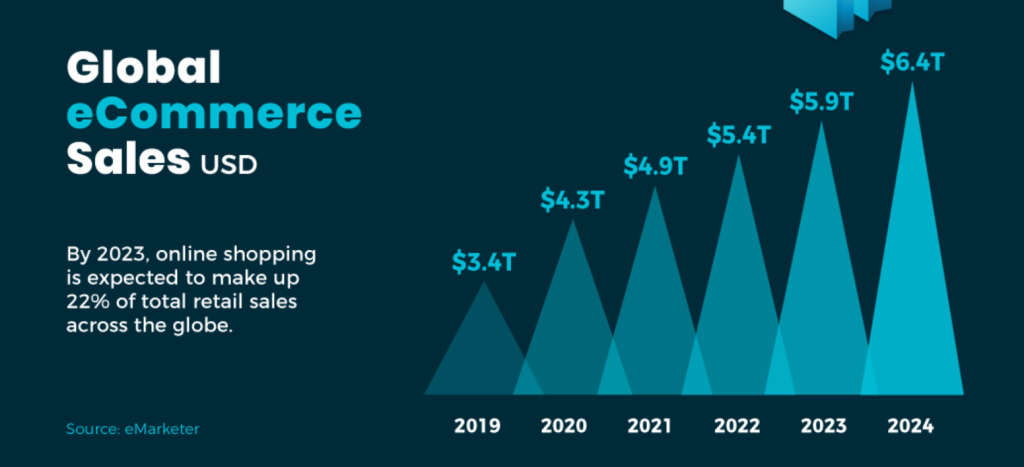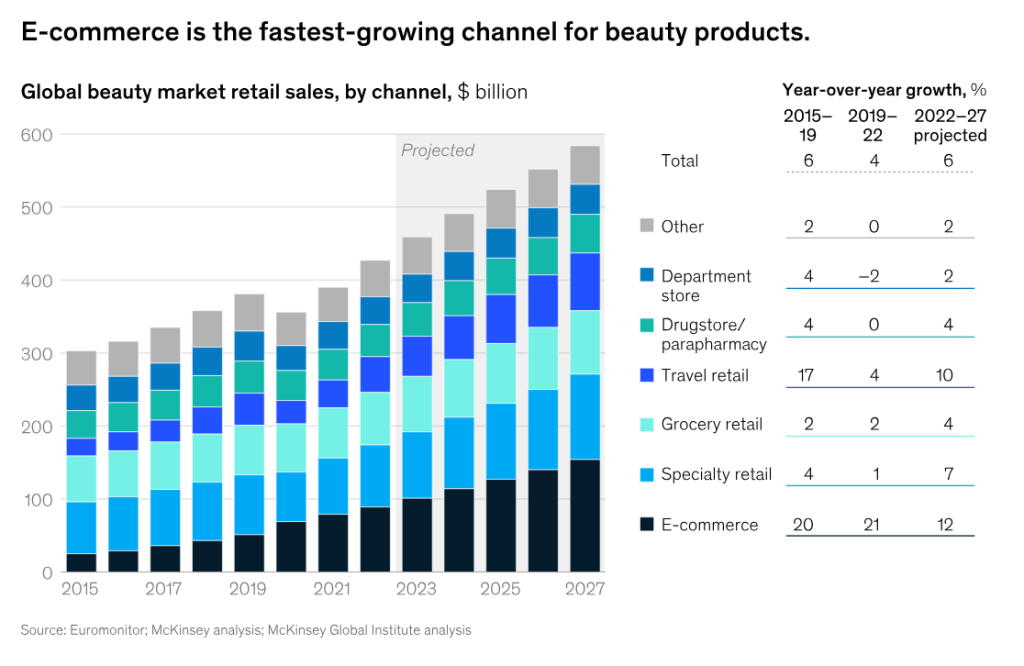
INTRODUCTION
In an era where technology permeates every aspect of our lives, perhaps nowhere is its impact more profound than in the way we shop. Online shopping, the digital marketplace accessible with just a few clicks or taps, has undergone a remarkable evolution, reshaping the retail landscape. From humble beginnings to becoming a global phenomenon, online shopping has not only revolutionized how consumers make purchases but has also challenged traditional retail models. However, as we revel in the ease of clicking “add to cart” from the comfort of our homes, we must also address the complexities and consequences of this digital revolution. Online shopping is a double-edged sword, transforming how we buy and sell goods while simultaneously raising questions about environmental, economic, and social impact.
The Renovation of Online Shopping
The transformation of commerce from physical stores to virtual marketplaces has been nothing short of revolutionary. Online shopping, often referred to as e-commerce, has evolved dramatically over the past few decades. Initially, it was a novel concept, limited to a few tech-savvy early adopters. However, with the advent of the internet and technological advancements, online shopping has grown into an enormous industry.
In the early 1990s, the seeds of online shopping were sown with the creation of the World Wide Web. Companies like Amazon and eBay emerged as pioneers in the field, experimenting with the idea of selling goods online. Amazon, founded in 1994, started as an online bookstore but quickly expanded to offer a diverse range of products (Popovic & Hulina, 2019). eBay, on the other hand, created an online auction platform where individuals could buy and sell items. In 2021, over 2.14 billion people worldwide were estimated to shop online, up from 1.66 billion global digital buyers in 2016.
As the internet became more accessible and user-friendly, online shopping gained momentum. Consumers appreciated the convenience of browsing and purchasing products from their homes. Secure online payment systems and the introduction of encryption technology further bolstered consumer confidence. Online retailers started offering features like customer reviews, product recommendations, and hassle-free return policies, making the online shopping experience more attractive.

The Pros of Online Shopping
- Unparalleled Convenience and Accessibility
Foremost among the merits inherent to online shopping is the unparalleled convenience and accessibility it affords (Childers et al., 2001). The temporal and spatial constraints that typify conventional brick-and-mortar retail become obsolete in the digital realm (Grewal et al., 2004). The capacity to execute transactions asynchronously, irrespective of geographical coordinates or temporal stipulations, confers a conspicuous advantage upon the contemporary consumer (Beldad et al., 2010).
An illustrative case is that of the modern professional ensnared in the constraints of a tightly regimented schedule. Through the agency of online shopping, this demographic can seamlessly procure a panoply of necessities, from groceries to electronics, devoid of physical sojourns. E-commerce, particularly expedited by services such as Amazon Prime, now extends the promise of same-day or next-day delivery, thereby underwriting the tenets of convenience.
- Expansive Product Variety and Selection
Integral to the appeal of online shopping is the panorama of product variety and selection that it proffers (Braga & Jacinto, 2022). The ostensible absence of spatial constraints in the digital marketplace liberates e-commerce platforms to curate a prodigious repository of wares. This transcendence of physical limitation converges to accord consumers access to an eclectic assortment of products, ranging from esoteric niche items to globally sourced commodities.

In China, as many as three-quarters of fashion brands start in online stores, where they prioritize the release of their latest products. Therefore, for consumers, the items on fashion shopping software are far more than the offline clothing stores, so that they can always pick their favourite items (Wyman, 2021). Furthermore, Consumers can find niche or specialized items that may not be readily available in traditional brick-and-mortar stores. Online boutiques and marketplaces, represented by platforms such as Etsy, can offer niche clothing and accessories to discerning consumers with a unique preference for clothing, thus attaining a level of consummate personalization rarely encountered in conventional retail.
- Competitive Pricing Dynamics and Discernible Discounts

The phenomenon of competitive pricing emerges as a salient hallmark of online retail, one that is undergirded by the economic efficiencies of reduced overhead costs and keenly competitive marketplaces. In the vanguard of this disposition, the online consumer is invariably the beneficiary of cost-efficient pricing models and enticements by way of discounts, thereby augmenting their purchasing power and optimizing the discernment of judicious consumer choices.
One of the best examples of price competition is the Internet beauty industry. Sellers will entice consumers to place orders by offering a large number of giveaways or by selling a combination of makeup sets at a lower price. In addition, they will allow beauty giant bloggers to sell their products at the lowest price on the Internet, in order to expand the consumer base and increase the influence, so as to drive sales in a way of small profits. According to a survey conducted by PowerReviews, 49% say they now spend more than $50 online on beauty products; compared to 16% than when we asked this same question in 2019 (Team, 2022).

The Cons of Online Shopping
- Absence of Physical Experience and Sensory Engagement
A palpable deficit associated with online shopping is the paucity of physical engagement and sensory interaction that characterizes traditional brick-and-mortar retail experiences. The inability to physically inspect and assess products—whether it be the texture of fabric or the ergonomics of an appliance—can lead to disparities between consumer expectations and the delivered product. Moreover, the absence of immediate gratification through tactile and sensory engagement can diminish the experiential aspect of shopping, which for some consumers, remains an indispensable facet of the purchasing process.
- Environmental and Social Implications

The digital transformation of shopping has yielded a complex tapestry of environmental and social implications that demand discerning scrutiny (Su et al., 2020). The expedited delivery models integral to online shopping, while offering unrivalled convenience, engender heightened packaging waste and contribute to the carbon footprint through extensive transportation requirements (Pinos et al., 2022).
Notable examples include the exponential rise in single-use packaging waste, a byproduct of the ‘Amazon effect,’ and the dilution of the communal fabric as small, locally-owned businesses struggle to compete with e-commerce giants, thereby engendering social and economic perturbations (Su et al., 2020).
- Live-Streaming E-Commerce Trap
One particular set of difficulties presented by live-streaming e-commerce is the potential for overstated product promises. As presenters use persuasion strategies, such as hype and pressure approaches, to encourage rapid purchases, overstating product promises becomes a constant worry. In the era of online shopping, individuals’ emotional reactions, irrational impulses, or reduced cognitive constraints drive impulsive purchasing. This behaviour is sparked by enticing goods that prompt impulsive purchases from consumers, frequently without appropriate consideration of their financial situation or other relevant variables (Verhagen & Van Dolen, 2011; Rahman & Hossain, 2022). When consumers make decisions on the spur of the moment, they may later experience buyer’s remorse and regret their decisions.

At the stroke of midnight on February 24, 2020, as Jiaqi Li concluded his presentation, a staggering 20 million viewers, engrossed in his live-streamed broadcast, expeditiously procured an astonishing 80,000 units of eyeshadow in a mere fraction of a second. A portion of these consumers exhibit genuine interest in the product, while the majority are prompted to emulate the purchase, thereby conferring substantial advantages upon the business. While some consumers may entertain the idea of post-purchase product returns driven by regret, the prevailing perception of the product’s modest price point often dissuades such actions, as the costs associated with return postage are perceived as outweighing the product’s value. In the long run, it will cause huge waste and loss of money for buyers.
CONCLUSION
In the ever-evolving landscape of retail, the metamorphosis from traditional brick-and-mortar stores to virtual marketplaces, exemplified by the phenomenon of online shopping, is nothing short of revolutionary. This digital transformation has redefined how consumers make purchases, offering unprecedented convenience, an expansive product selection, and competitive pricing dynamics. As technology continues to advance, society must grapple with the intricate interplay between convenience and complexity, consumerism and responsibility, and innovation and its consequences. Navigating this evolving retail terrain requires thoughtful consideration of both the opportunities and the pitfalls, ensuring that the path forward aligns with the best interests of consumers, businesses, and the global ecosystem.
Reference
Beldad, A., De Jong, M., & Steehouder, M. (2010). How shall I trust the faceless and the intangible? A literature review on the antecedents of online trust. Computers in Human Behavior, 26(5), 857–869. https://doi.org/10.1016/j.chb.2010.03.013
Braga, J. N., & Jacinto, S. (2022). Effortless online shopping? How online shopping contexts prime heuristic processing. Journal of Consumer Behaviour, 21(4), 743–755. https://doi.org/10.1002/cb.2032
Childers, T. L., Carr, C. L., Peck, J., & Carson, S. (2001). Hedonic and utilitarian motivations for online retail shopping behavior. Journal of Retailing, 77(4), 511–535. https://doi.org/10.1016/s0022-4359(01)00056-2
Grewal, D., Iyer, G. R., & Levy, M. (2004). Internet retailing: Enablers, limiters and market consequences. Journal of Business Research, 57(7), 703–713. https://doi.org/10.1016/s0148-2963(02)00348-x
Pinos, J., Hahladakis, J. N., & Chen, H. (2022). Why is the generation of packaging waste from express deliveries a major problem? Science of the Total Environment, 830, 154759. https://doi.org/10.1016/j.scitotenv.2022.154759
Popovic, D., & Hulina, D. (2019). Survival of the fittest in the e-commerce market: The dot-com bubble and Amazon. Review of Contemporary Business, Entrepreneurship and Economic Issues, 32(1), 79-96.
Rahman, M. F., & Hossain, S. (2022). The impact of website quality on online compulsive buying behavior: evidence from online shopping organizations. South Asian Journal of Marketing. https://doi.org/10.1108/sajm-03-2021-0038
Su, Y., Duan, H., Wang, Z., Song, G., Kang, P., & Chen, D. (2020). Characterizing the environmental impact of packaging materials for express delivery via life cycle assessment. Journal of Cleaner Production, 274, 122961. https://doi.org/10.1016/j.jclepro.2020.122961
Team, P. (2022, June 3). The changing face of the beauty shopper. PowerReviews. https://www.powerreviews.com/insights/2021-beauty-industry-consumer-report/
Verhagen, T., & Van Dolen, W. (2011). The influence of online store beliefs on consumer online impulse buying: A model and empirical application. Information & Management, 48(8), 320–327. https://doi.org/10.1016/j.im.2011.08.001
Wang, Y., Lu, Z., Cao, P., Chu, J., Wang, H., & Wattenhofer, R. (2022). How live streaming changes shopping decisions in e-commerce: A study of live streaming commerce. Computer Supported Cooperative Work, 31(4), 701–729. https://doi.org/10.1007/s10606-022-09439-2
ARIN2610 – Internet Transformations
Proudly powered by WordPress



